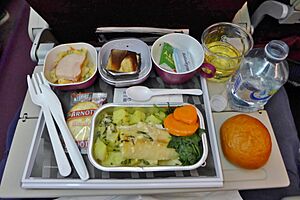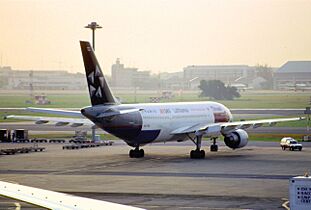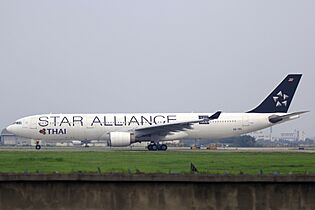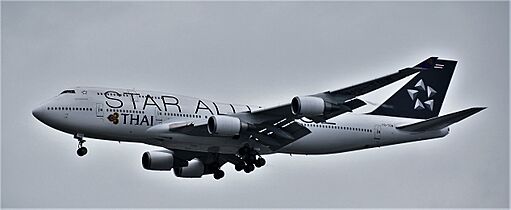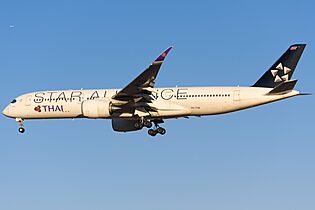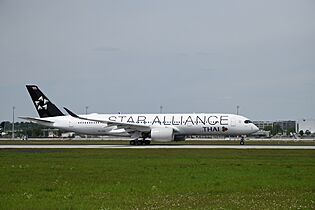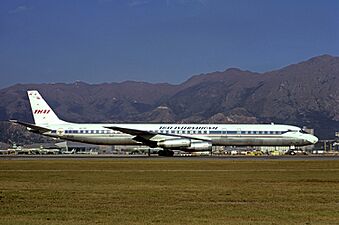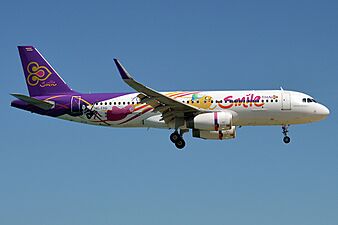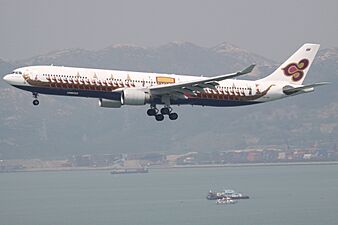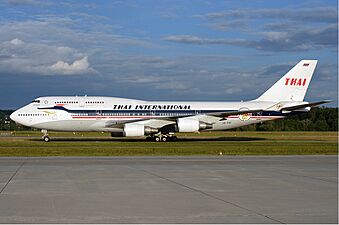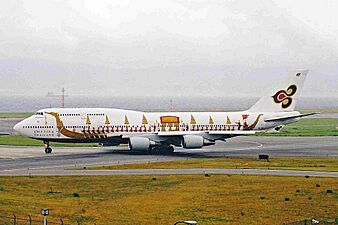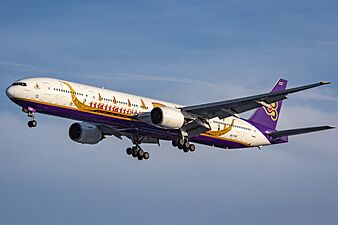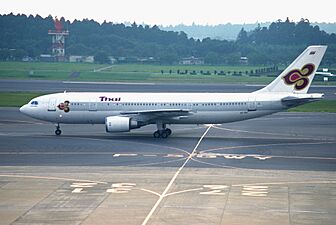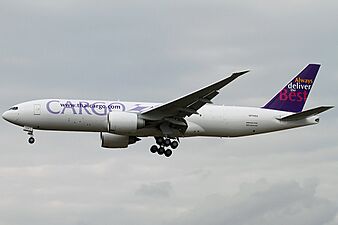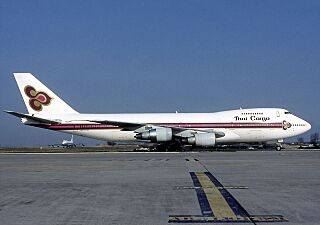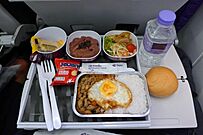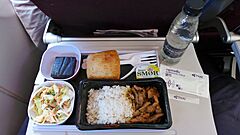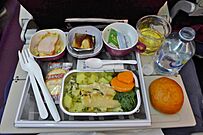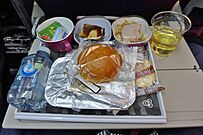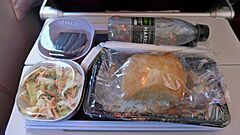Thai Airways International facts for kids
A Thai Airways Airbus A350-900
|
|
| Founded | 29 March 1960 (as Thai International) |
|---|---|
| Commenced operations | 1 April 1988 (merger with Thai Airways Company) |
| AOC # | AOC.0003 |
| Hubs | Bangkok–Suvarnabhumi |
| Focus cities |
|
| Frequent-flyer program | Royal Orchid Plus |
| Alliance | Star Alliance |
| Subsidiaries |
|
| Fleet size | 77 |
| Destinations | 65 |
| Parent company | Ministry of Finance (47.86%) |
| Headquarters | 89 Vibhavadi Rangsit Road, Chatuchak, Bangkok 10900, Thailand |
| Key people | |
| Revenue | |
| Net income | |
| Total assets | |
| Employees | 16,000 (2025) |
Thai Airways International is the main airline of Thailand. It is often called THAI. The airline started in 1961 as a partnership between SAS and a Thai airline. Its main office is in Bangkok, and most of its flights take off from Suvarnabhumi Airport.
THAI is one of the airlines that helped create Star Alliance, which is a big group of airlines that work together. THAI also owns a small part of another airline called Nok Air. In 2012, THAI started a regional airline called Thai Smile, but it was later brought back into Thai Airways in 2023.
THAI flies to many places around the world, including cities in Europe, Asia, and Oceania. It also flies to several cities within Thailand. The airline uses a mix of large and smaller planes from both Boeing and Airbus. As of May 2025, THAI has 77 planes and plans to get more in the future.
Contents
History of Thai Airways

How it Started
Thai Airways International began in 1960. It was a joint project between Scandinavian Airlines System (SAS) and Thailand's own airline, Thai Airways Company. SAS helped with how to run the airline, manage it, and market it. They also trained Thai people to take over all the jobs. This helped Thailand have its own airline that could run on its own.
In 1971, THAI started flying to other continents, first to Australia, and then to Europe the next year. They added bigger planes like the Douglas DC-10 in the late 1970s. Flights to North America began in 1980.
By 1977, the Thai government bought all the shares from SAS. This made Thai Airways a company owned by the Thai government. Later, in 2020, the government reduced its ownership to less than half.
Joining Forces and Growing
On April 1, 1988, the international and domestic flights of the two Thai airlines were combined. This created the Thai Airways International we know today. This made it easier to have one big national airline. In 1991, the company's shares were offered to the public on the Stock Exchange of Thailand.
In 1997, Thai Airways was one of the five airlines that started Star Alliance. This was the world's first and largest airline group. The other founding airlines were Lufthansa, Air Canada, SAS, and United Airlines.
During the 1990s, THAI bought many different types of planes. This meant they needed to train many technicians to fix all the different models and engines. This made their maintenance costs much higher.

New Routes and Challenges
In the early 2000s, Thai Airways added many new flight routes to cities like Chengdu, Busan, Milan, and Moscow.
THAI also started non-stop flights to New York City and Los Angeles in 2005 using Airbus A340-500 planes. However, because fuel became very expensive, they stopped the New York flights in 2008. The Los Angeles flight later became a one-stop flight.
Around this time, THAI also started flying directly from Phuket to other countries, not just from Bangkok.
In 2008, after being profitable for 40 years, THAI lost money for the first time. This was due to high fuel prices and problems within Thailand. After making some changes, the airline started making a profit again in 2009.
Modernizing the Fleet
In 2010, THAI celebrated its 50th anniversary. The airline made plans to get new planes, like the Boeing 787 and Airbus A350, and to improve its existing planes. They also got rid of older planes that used too much fuel. THAI received its first Airbus A380 plane in 2012.
THAI also started flying to Brussels again and added new non-stop flights from Stockholm and Copenhagen to Phuket.
In 2015, Thailand's aviation safety rating was lowered by international groups. This meant Thai airlines could not start new flights to the United States. However, THAI was still allowed to fly to Europe. In July 2015, THAI stopped its flights to Los Angeles, ending its service to the US.
By November 2024, regulators announced that Thailand was expected to get its top safety rating back in early 2025. This would allow Thai Airways to fly to the United States again. On December 1, 2024, Thai Airways resumed flights to Brussels, Belgium, after a four-year break.
Recent Changes and Future Plans
In May 2020, the Thai government approved Thai Airways asking for help to manage its large debt. This was made worse by the COVID-19 pandemic. The government later sold some of its shares, so THAI was no longer fully owned by the state.
In September 2020, a court in Bangkok approved THAI's plan to reorganize its business. This was a very big step for the company.
In February 2023, it was announced that Thai Smile, THAI's smaller airline, would join back with Thai Airways by 2024 to help reduce losses. Thai Smile's last flight was on December 31, 2023.
As of May 2025, Thai Airways is looking into flying to the United States again, possibly through Osaka. However, their current 10-year plan focuses on flying more often to popular routes like Paris and restarting flights to Vienna and Amsterdam, because they don't have enough planes for new US routes yet.
Thai Airways Brand
Safety Video
The safety video shown on Thai Airways flights was updated in 2018. Some people felt that the video did not show enough Thai culture.
Thai Smile Airline
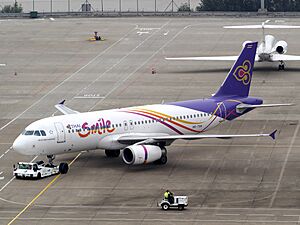
THAI started a regional airline called Thai Smile in 2012. This airline used smaller planes for flights within Thailand and to nearby countries. Thai Smile flew to many destinations, with Chiang Mai International Airport as a main hub.
In 2016, Thai Smile added new flights to cities in India. They also planned to restart flights to places like Da Nang and Luang Prabang. However, because of money problems from the COVID-19 pandemic, Thai Smile stopped flying in 2023. All its planes are now part of Thai Airways.
Other Businesses
Thai Catering
Thai Catering makes meals for airlines. It started in 1960. Today, its main kitchen is at Suvarnabhumi Airport and can make many thousands of meals every day. They also have a bakery and make food for airline lounges and special events. Thai Catering has won awards for its economy class food.
In 1995, Thai Catering started a bakery called Puff and Pie Bakery House to earn more money. These bakeries sell baked goods and ready-to-eat meals in Bangkok.
Plane Designs and Logos
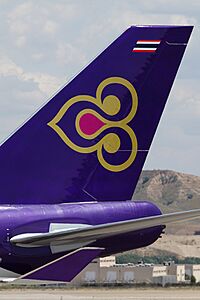
In 2006, when Thai Airways moved its main hub to the new Suvarnabhumi Airport, it also updated its brand. This included new designs on its planes, new seats, and improved service.
The logo on the tail of the plane looks like the traditional Thai greeting called "wai." The curved lines are like the decorative parts of Thai temples. The gold color represents Thai temples, the magenta is for magnolia flowers, and the purple is for Thai orchids. Purple is a color used throughout the airline, from uniforms to the inside of the planes.
Special Plane Designs
In 1999, THAI painted a special design of the Royal Barge Suphannahong on two of its Boeing 747-400 planes. These planes were named "Haripunchai" and "Bowonrangsi."
To celebrate the coronation of King Rama X, Thai Airways also put the Suphannahong Royal Barge design on a Boeing 777-300 plane.
As of 2025, two THAI planes have the special Star Alliance design, showing they are part of that airline group.
- Star Alliance Livery
-
Airbus A300B4-622R (HS-TAO)
-
Airbus A330-343 (HS-TBD)
-
Airbus A330-322 (HS-TEL)
-
Boeing 747-4D7 (HS-TGW)
-
Airbus A350-941 (HS-THQ)
-
Airbus A350-941 (HS-THU)
- Other Livery
-
Douglas DC-8-63 (HS-TGY) in Classical Thai Dancer livery
-
Thai Smile Airbus A320-232(WL) (HS-TXQ) in Cartoon Network Livery
-
Airbus A330-322 (HS-TEK) in the Royal Barge Narai Song Suban Livery.
-
Boeing 747-4D7 (HS-TGP) in the retro livery
-
Boeing 747-4D7 (HS-TGO) in the Royal Barge Suphannahong livery
-
Boeing 777-3D7 (HS-TKF) in the Royal Barge Suphannahong livery
-
Airbus A300-605R (HS-TAH) in the Speedline livery
-
Airbus A320-232(WL) (HS-TXT) in Ribbon Livery
-
Boeing 747-4D7 (HS-TGZ) in The King 72nd Celebration livery
-
Boeing 747-4D7 (BCF) (HS-TGH) in the Thai Airways International Cargo livery
-
Boeing 777-FZB (N775SA) in the Always Deliver The Best livery
-
Boeing 747-2D7B(SF) (N522MC) in the Thai Airways International Lowercase letter Cargo livery
-
Douglas DC-8-62AF (HS-TGS) in the Thai Airways International Capital Letter CARGO livery
How Thai Airways is Run

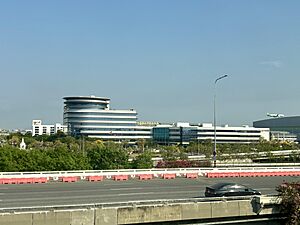
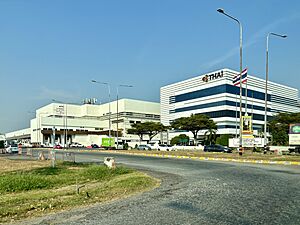
Financial Situation
Thai Airways has faced financial challenges over the years. In 2014, the company had a large financial loss. This was partly due to fewer tourists visiting Thailand at that time.
In 2018, THAI's new leaders aimed to make the airline profitable again by 2022. They planned to buy 23 new planes because their old ones were expensive to keep. They also worked with other Thai companies to bring more tourists to less-known parts of Thailand.
Managing Debt
In April 2020, the Thai government first offered to help THAI with a large loan. However, this plan was changed. Instead, THAI was asked to file for debt restructuring in court. This means they would work with a court to manage their debts and pay back what they owed.
In May 2020, the Ministry of Finance sold some of its shares in THAI. This meant the airline was no longer mostly owned by the government.
In September 2020, the court approved THAI's plan to reorganize its business. This was a very big step for the company to get back on track. The plan was approved again in June 2021 and updated in October 2022.
Thai Airways has many shareholders, which are people or groups who own parts of the company. The biggest shareholder is the Ministry of Finance. Other shareholders include banks and various savings cooperatives.
Where Thai Airways Flies
Thai Airways International flies to many places around the world. It also has flights within Thailand.
Partner Airlines
Thai Airways works with many other airlines through "codeshare agreements." This means they can sell tickets on each other's flights. This helps passengers travel to more places easily. Some of these partner airlines include:
- Air Canada
- Air India
- Air Macau
- Air New Zealand
- All Nippon Airways
- Asiana Airlines
- Austrian Airlines
- Avianca
- Bangkok Airways
- Brussels Airlines
- Egyptair
- El Al
- Emirates
- EVA Air
- Gulf Air
- Kuwait Airways
- Lao Airlines
- Lufthansa
- Malaysia Airlines
- Oman Air
- Pakistan International Airlines
- Royal Brunei Airlines
- Scandinavian Airlines
- Shenzhen Airlines
- Singapore Airlines
- Swiss International Air Lines
- TAP Air Portugal
- Turkish Airlines
- United Airlines
Thai Airways Planes
Thai Airways uses both large planes (wide-body) and smaller planes (narrow-body) from Airbus and Boeing. As of May 2025, the airline has 77 planes and has ordered 90 more.
Plane Maintenance Centers
THAI has three places where it fixes and maintains planes: at U-Tapao International Airport, Don Mueang International Airport, and Suvarnabhumi Airport. These centers fix planes for THAI and other airlines too.
THAI Technical
THAI Technical is the part of the airline that handles plane maintenance. It has special certifications from international aviation groups, meaning it meets high safety and quality standards.
Cleanliness and Safety
Thai Airways has a program called "The Most Hygienic In-Cabin Environment Program." This program focuses on keeping the air clean, surfaces spotless, and food safe on all flights. After each flight, all disposable items are removed, and the cabin equipment is cleaned and disinfected. The air system is also checked.
THAI was the first airline to use special air filters called True HEPA filters. These filters can catch almost all dust and tiny living things in the air. In 2004, the World Health Organization gave THAI an award for its in-cabin cleaning system.
Services on Board
Cabin Classes
Thai Airways offers different types of seating for passengers: Royal First Class, Royal Silk Class, Premium Economy, and Economy. In April 2025, THAI announced plans to update the seats on some of its Boeing 777-300ER and older Airbus A350-900 planes. They will get new Royal Silk and Economy Class seats, and also a new Economy Plus Class.
Royal First Class
Royal First Class is the most luxurious option. It is only available on three Boeing 777-300ER planes that fly to London, Tokyo, and Osaka. Each seat is very wide and long, turning into a fully flat bed for maximum comfort and privacy.
Royal Silk Class
Royal Silk Class is Thai Airways' business class. It is available on all their planes. Most Royal Silk Class seats can turn into fully flat beds, except on the Airbus A320-200 and Boeing 777-200ER. The seats are usually white and dark purple.
Airbus A320-200
Royal Silk Class on the Airbus A320-200 was added in January 2025. These seats are like comfortable recliners. Passengers can use their own devices for entertainment through the plane's Wi-Fi. This class is mainly for flights within Thailand and some regional routes.
Airbus A330-300
Thai Airways has two different Royal Silk Class setups on its Airbus A330-300 planes. One type has special "throne seats" in some rows. The other type, found on two planes that used to belong to another airline, has a unique angled layout.
Airbus A350-900
There are four different Royal Silk Class layouts on the Airbus A350-900 planes. These layouts vary slightly in how the seats are arranged. Some of these planes used to fly for other airlines.
Boeing 777-200ER
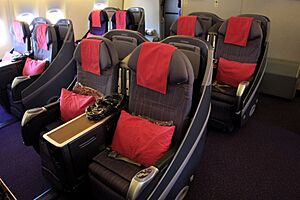
This plane has the oldest Royal Silk Class seats in the fleet, which are recliner seats. These planes are expected to be retired by 2026.
Boeing 777-300ER
This plane has a staggered seat layout. It is planned to be updated with new Royal Silk Class seats that will have privacy doors.
Boeing 787-8
This plane has a 2-2-2 seat layout.
Boeing 787-9
Royal Silk Class on the Boeing 787-9 has a reverse-herringbone layout.
Premium Economy
Premium Economy offers more space and comfort than Economy Class. It was first on the Airbus A340-600 planes, which were retired in 2015. THAI brought this class back in 2024 on two Airbus A330-300 planes. The new Boeing 787-10 will also have Premium Economy, as will some updated Airbus A350-900 and Boeing 777-300ER planes.
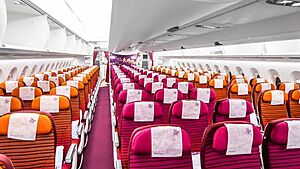
Economy Class
Economy Class is the standard seating. On large planes, seats are usually in a 3-3-3 arrangement, while smaller planes have a 2-2 setup. The seats are typically orange and magenta.
Lounges
Thai Airways has special lounges for passengers at airports called Royal Orchid Lounge and Royal Silk Lounge. These are places where passengers can relax before their flights.
Domestic Lounges
- Suvarnabhumi Airport
- Chiang Mai International Airport
- Phuket International Airport

International Lounges
- Suvarnabhumi Airport
- Chiang Mai International Airport
- Phuket International Airport
- Hazrat Shahjalal International Airport
- Hong Kong International Airport
- Tribhuvan International Airport
- Kuala Lumpur International Airport
- Ninoy Aquino International Airport
- Singapore Changi Airport
Food on Flights
Thai Airways offers different kinds of meals on its flights, including Thai and international dishes. The meals depend on where the plane is going and the time of year. Passengers can also choose their meals up to 72 hours before their flight.
- Economy Class meal
Royal Orchid Plus Program
Royal Orchid Plus is Thai Airways' program for frequent flyers. Members earn points, called "miles," when they fly with THAI or its partner airlines. These miles can be used for free flights or upgrades. There are different levels in the program: Member, Silver, Gold, and Platinum, depending on how many miles a person earns in a year.
Sponsorships
Thai Airways has sponsored sports teams and events. For example, it signed a sponsorship deal with the English Football League (EFL) in 2017, which continued into 2020. In 2019, THAI also sponsored Australian Rugby Team Melbourne Rebels and the Australian A-League soccer club Western Sydney Wanderers.
Plane Incidents
Aviation incidents are rare, but they can happen. Here are some incidents involving Thai Airways planes:
- June 30, 1967: A plane crashed into the sea while landing in a typhoon, and some people on board died.
- July 9, 1969: A plane landed roughly during a thunderstorm, but everyone survived. The plane was too damaged to fly again.
- May 10, 1973: A plane went off the end of the runway while landing in Kathmandu. Everyone on board survived, but one person on the ground died.
- October 26, 1986: A grenade exploded on a plane flying over Japan, but the plane landed safely, and everyone survived.
- June 27, 1989: A Thai Airways plane's wing hit another plane while taxiing at London Heathrow Airport.
- November 10, 1990: A plane was taken over by four students who wanted to go to India. They later gave up.
- July 31, 1992: A plane crashed into a mountain near Kathmandu due to pilot error and bad weather. Everyone on board died.
- October 22, 1994: A parked Thai Airways plane was hit by another Thai Airways plane that was testing its engines.
- December 11, 1998: A plane crashed in heavy rain while trying to land in Surat Thani, Thailand. Many people died.
- March 3, 2001: A plane was destroyed by an explosion while parked at the gate in Bangkok. One crew member died.
- August 8, 2004: A plane's nose landing gear broke during landing in Mae Hong Son, Thailand.
- April 19, 2005: A Thai Airways plane's wing hit another airline's plane while taxiing at Bangkok Don Mueang International Airport.
- July 15, 2006: A Thai Airways plane collided with another plane while taxiing at Madrid-Barajas Airport.
- September 8, 2013: A plane went off the runway while landing at Suvarnabhumi Airport. The plane was badly damaged, and some people had minor injuries. The airline covered its logo on the damaged plane, which caused some discussion. The plane was later turned into a roadside attraction.
- March 9, 2020: A Thai Airways plane hit a parked business jet at Wattay International Airport in Laos.
- June 10, 2023: A Thai Airways plane collided with another airline's plane at Haneda Airport in Tokyo. No one was hurt, but both planes had minor damage.
Images for kids
-
A Thai McDonnell Douglas DC-10 at Frankfurt Airport in 1977
See also
 In Spanish: Thai Airways para niños
In Spanish: Thai Airways para niños


